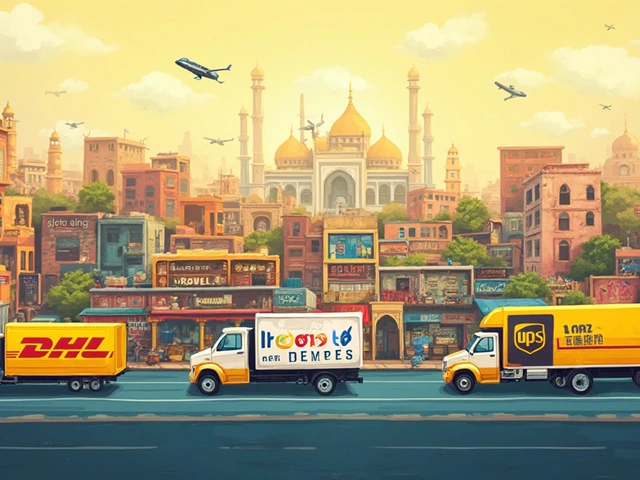Ever get that tracking notification and feel a little rush? You’re not the only one. The real MVPs of courier services aren’t just big companies—everyday people are sending and receiving more parcels than ever. In 2024 alone, over 80% of online shoppers in the US used a courier service at least once a month. Shopping online means we expect our stuff quickly, and courier companies are the middlemen making sure your phone case or groceries actually show up at your door.
But it’s not just about buying things. Small businesses, side hustlers, and even folks flipping sneakers on Instagram all count on couriers to move their packages fast and reliably. If your business promises next-day delivery, your courier is just as crucial as your product.
- Everyday Online Shoppers and Their Habits
- How Small Businesses Rely on Couriers
- Couriers in Healthcare and Urgent Deliveries
- eBay, Etsy, and the Rise of Individual Sellers
Everyday Online Shoppers and Their Habits
If you’ve ever double-checked your porch for a package or tracked a delivery from your phone, you’re part of the club. Today, everyday shoppers are a major driving force behind courier services. Here’s the thing: people don’t just want to buy online—they want stuff fast. In 2024, the average American made 53 online purchases per year, and 75% of those were delivered by a courier. Amazon’s “next-day” obsession changed the game, and everyone—big or small—is trying to keep up.
Let’s look at how the habits of online shoppers are shaping the courier industry:
- Speed Matters: Over 60% of online shoppers decide where to buy based on delivery speed. If a site can’t offer two-day shipping, many will just click elsewhere.
- Tracking is Everything: Around 86% of shoppers say real-time tracking is a must-have. People like knowing where their stuff is every step of the way.
- More Returns: With more online orders, there’s also a huge spike in returns. Couriers are busier than ever picking up unwanted shoes or wrong-sized t-shirts from people’s doorsteps.
- Rural vs. City: City dwellers use couriers more often, but rural customers rely heavily on these services to get essentials they can’t find locally.
Check out these quick stats from 2024 to get a feel for what’s happening:
| Metric | Value |
|---|---|
| Average deliveries per US shopper/year | 53 |
| % of online orders with same/next-day delivery | 41% |
| Share of shoppers tracking every package | 68% |
| Online buyers who made at least one return | 54% |
So, next time a package lands on your steps—whether it’s pet food or a tech gadget—remember you’re one of millions shaping how fast and far couriers go every day.
How Small Businesses Rely on Couriers
Small businesses live and die by quick, reliable deliveries. Whether you’re selling handmade candles, T-shirts, electronics, or even local baked goods, getting that order out fast is non-negotiable. Customers have gotten used to two-day shipping, and sometimes even same-day. That’s put courier services at the heart of every small shop’s workflow.
The biggest draw for small businesses? Flexibility. Couriers pick up from virtually anywhere—shops, homes, storage units—and deliver direct to customers, skipping the long wait times of traditional mail. Lots of businesses use couriers to send goods across town, but an increasing number use them for regional and even cross-country drops, thanks to easy online booking and tracking tools.
Here’s a look at what small businesses value most about modern courier services:
- Speed: Next-day or same-day delivery is standard in many cities.
- Tracking: Real-time updates let customers know exactly when to expect parcels.
- Door-to-door convenience: No post office runs, couriers come to you.
- Personalized service: Options for fragile, bulky, or time-sensitive shipments.
During busy periods—think holiday rush—courier companies see a big spike from the small business crowd. FedEx reported in 2023 that shipments from online sellers and independent stores jumped 35% between Black Friday and New Year’s Day, compared to regular months. That’s a huge chunk of business riding on fast, reliable delivery.
| Courier Service | Popular With | Main Reason Used |
|---|---|---|
| UPS | Local retail shops | Reliable next-day delivery |
| FedEx | Online sellers | Affordable two-day shipping |
| USPS | Home-based businesses | Lowest-cost shipping for smaller items |
| Local couriers | Bakeries, florists | Same-day delivery, even on weekends |
One practical tip? If you're a small business, don't just stick with one provider. Compare rates and delivery times each week. Sometimes, a local service beats the big names, especially for same-day drops within the city. Another trick: printing shipping labels at home saves time and usually gets you a bit of a discount.
Without courier services, most small shops just wouldn’t be able to compete with Amazon’s speed. These partnerships are what keep the little guys in the game—and customers coming back for more.

Couriers in Healthcare and Urgent Deliveries
Courier services aren’t just about shipping shoes or gadgets—they play a huge role in healthcare too. Hospitals, clinics, and pharmacies count on same-day and even one-hour deliveries for super time-sensitive stuff. Think about labs sending blood samples, pharmacies delivering medication to patients who can’t leave home, or hospitals moving organs and donor tissue. In fact, the medical courier market in the US was worth over $7 billion in 2024, and it’s still growing fast.
What’s wild is how precise these deliveries have to be. Some meds need to stay chilled, so couriers use temperature-controlled vans. Lab samples have expiration times, so there’s zero room for delays. Even blood banks depend on couriers for getting supplies to emergency rooms during crises. If you want speed, reliability, and proper handling, regular mail just doesn’t cut it.
- Certain vaccines and insulin must stay between 2°C and 8°C, and dedicated medical couriers are trained for this.
- Pharmacies in big cities like New York and LA often use couriers for same-day prescription drops, especially for older or homebound patients.
- Pathology labs clock up thousands of courier miles a week just moving samples to get results quicker for anxious patients.
| Type of Medical Delivery | Urgency Level | Special Requirements |
|---|---|---|
| Blood Samples | Within Hours | Temperature Control |
| Organ Transplants | Immediate (1-4 Hours) | Strict Timing, Human Accompaniment |
| Prescription Meds | Same-Day | Signature Required |
And here’s a pro tip—if you need to send something for healthcare, don’t just book any delivery. Look for couriers who specialize in medical shipments. They train for emergency runs and keep up with legal rules for medical stuff. When every minute—or degree—counts, you want a pro on the job.
No wonder the courier services industry has seen a surge in urgent, healthcare-related jobs. When it’s literally life or death, speed and reliability matter way more than price.
eBay, Etsy, and the Rise of Individual Sellers
You’d be surprised how many packages flying around come from regular people—not big brands. Since 2020, platforms like eBay, Etsy, and Depop have seen huge growth in individual sellers. People are flipping old game consoles, handmade candles, retro sneakers, and more. The numbers don’t lie: Etsy’s 2024 annual report showed over 7.5 million active sellers. On eBay, casual sellers (those not running stores) made up about 54% of all listings last year. That means way more individuals are jumping in and using courier services to get stuff to buyers fast.
The boom is driven by how easy it is for anyone to join the secondhand or creative marketplace. Got a box of rare Pokémon cards or a batch of custom T-shirts? You only need a smartphone and a courier account. Most sellers use reliable parcel services to offer tracking, insurance, and door-to-door pickup. Speed and buyer trust are key—the faster a package gets there, the better the reviews. Cutting corners on shipping just isn’t worth it if you want repeat business.
Here’s a quick look at just how much these platforms rely on couriers:
| Platform | Active Sellers (2024) | Estimated Daily Parcels (Worldwide) |
|---|---|---|
| Etsy | 7.5 million | Over 1.3 million |
| eBay | 24 million | Roughly 2 million |
| Depop | 2 million | About 350,000 |
Want to keep up if you sell online? Here’s what works best for part-time hustlers and solo sellers:
- Get a scale and printer—knowing the weight and printing labels yourself saves cash and time.
- Use parcel comparison sites to spot the best courier deals for your package size and speed.
- Offer tracked shipping—it costs a little more but almost always protects you in case of disputes.
- Think about eco-friendly packaging. Buyers love it and some couriers give discounts if you use recyclable stuff.
Selling online isn’t just for huge brands anymore, and couriers are the backbone letting anyone turn a side hustle into real cash. For millions, that rush of sending out a package and seeing five-star feedback is worth every shipping label.





